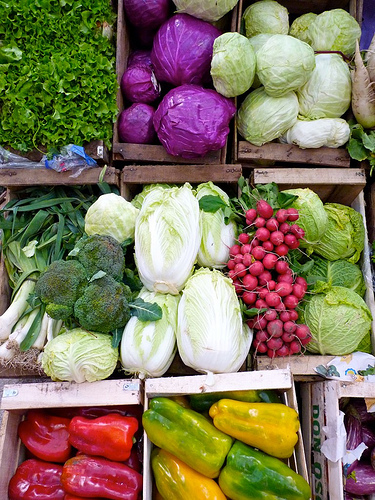
by Bonnie Coberly
The Stark Reality
 Seventy-five percent of annual American deaths are linked to food-related diseases such as cancer, cardiovascular disease and diabetes mellitus.
Seventy-five percent of annual American deaths are linked to food-related diseases such as cancer, cardiovascular disease and diabetes mellitus.
The grave relationship between diet and early death from these killers is no longer just theories or hypotheses.
Rather, the connection has been proven over and over again by hundreds of studies performed worldwide and throughout three decades.
Our diets must change in order to ensure that we eat “five to nine servings of fruits and vegetables a day.” A multivitamin does not replace our body’s needs for these natural foods.
Further, our ingestion of red meat must also decrease to lessen our cancer risk. For example, Harvard University studies indicate “that regular meat consumption increases colon cancer risk by roughly 300 percent.”
The Good News
There is good news for those who choose to decrease their cancer risks. The American Institute for Cancer Research (AICR) has condensed steps toward cancer prevention into three easily recalled and uncomplicated guidelines:
1. “Choose mostly plant foods, limit red meat and avoid processed meat.”
2. “Be physically active every day in any way for 30 minutes or more.”
3. “Aim to be a healthy weight throughout life.”
If you do not currently follow any of these guidelines and feel you may have a hard time adding such a drastic change to your lifestyle, progressively add each step to your regimen.
Start out by eating a balanced, more nutritious meal each day, that will help give you the energy to start being more active. Once you become more active, you can achieve the goal of maintaining a healthy weight throughout your life.
Tips for Increasing Plant Foods in Your Diet
Step #1: Establish a Family or Individual Plan
Most of the foods we reach for we do so without considering their health or nutritional value. We eat them out of habit and convenience. We often cook in the same way.
Aside from an occasional new recipe, most of the meals we prepare are old family standbys. Changing such deeply ingrained habits requires planning and strategizing for those times when our motivation is waning. This is the time for a family meeting, a new grocery list and a careful study of vegetarian or vegan recipes that can meet your family’s needs.
Step #2: Replace Meat with Substitute Meats in the Beginning
Use meat-like products such as “fakon,” soy hamburger, or soy “chicken nuggets” in the beginning.
You can substitute many of these different soy products directly into your regular mealtime recipes, saving you time and maintaining family favorites. These types of foods and products are usually a healthier alternative, provide more nutrition, and can taste just as great.
Step #3 Clean up Your Cabinets
Empty your cabinets of potato chips, artificial cheese spreads, store-bought dip, cookies and other temptations. The excuse that you are only keeping them to offer them to visitors isn’t true and doesn’t work.
Keep small servings of peeled and sliced carrots, radishes, celery and other raw vegetables for snacks and to curb cravings. Use homemade hummus for a dip, if necessary.
Step #4 Invest in a Food Processor
Increase the vegetable content and nutritional value of almost every dish you prepare using your food processor.
A large bag of washed spinach leaves, kale or collard greens from your grocery’s produce department can be finely chopped by your food processor into perhaps 1 to 1 1/2 cups of vegetable matter.
These finely diced greens can be added to soups, vegetable tacos, casseroles, smoothies and salads easily and without requiring a separate dish.
Step #5 Check Out Asian and Indian Vegetarian Recipes
Explore the flavors of new cuisines as you adopt your new diet.
Many Asian and Indian foods and flavors are meatless and delicious. Unlike the stereotype of a vegetarian or vegan diet, your meals need not be endless bowls of lentils. Instead, you can try to explore at least one new “foreign” flavor a week and make this change an adventure.
Here is an example of a South Asian recipe with beans. Here is another dish about South Asian raita dish.
Bon Appetite
Dietary changes such as those described above are not just for long-term protection against cancer. The increased fiber of most of the ingredients aids in digestions and helps decrease cholesterol and triglycerides.
Fresh fruits and vegetables provide antioxidants for more energy and help hair, eye and skin health. You have every reason to look forward to a lifetime of delicious meals, fresh foods and wonderful flavors.
(Bonnie Coberly writes for Natural Horizons Wellness Centers. Natural Horizons Wellness Centers is an integrative wellness and medicine practice based in Fairfax, VA that offers alternative cancer therapy for lung, breast, prostate and other types of cancer.)





Be the first to comment